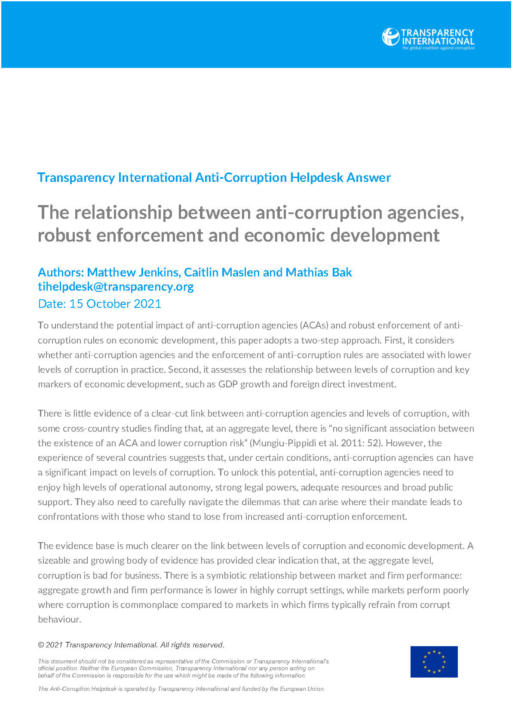- Home
- Anti-Corruption Helpdesk
- The relationship between anti-corruption agencies, robust enforcement and economic development
The relationship between anti-corruption agencies, robust enforcement and economic development

This Anti-Corruption Helpdesk brief was produced in response to a query from one of Transparency International’s national chapters. The Anti-Corruption Helpdesk is operated by Transparency International and funded by the European Union.
Query
Please provide an overview of evidence on the effectiveness of anti-corruption agencies and/or strength of enforcement of anti-corruption laws on economic development and foreign investment
Summary
To understand the potential impact of anti-corruption agencies (ACAs) and robust enforcement of anti-corruption rules on economic development, this paper adopts a two-step approach. First, it considers whether anti-corruption agencies and the enforcement of anti-corruption rules are associated with lower levels of corruption in practice. Second, it assesses the relationship between levels of corruption and key markers of economic development, such as GDP growth and foreign direct investment.
There is little evidence of a clear-cut link between anti-corruption agencies and levels of corruption, with some cross-country studies finding that, at an aggregate level, there is “no significant association between the existence of an ACA and lower corruption risk” (Mungiu-Pippidi et al. 2011: 52). However, the experience of several countries suggests that, under certain conditions, anti-corruption agencies can have a significant impact on levels of corruption. To unlock this potential, anti-corruption agencies need to enjoy high levels of operational autonomy, strong legal powers, adequate resources and broad public support. They also need to carefully navigate the dilemmas that can arise where their mandate leads to confrontations with those who stand to lose from increased anti-corruption enforcement.
The evidence base is much clearer on the link between levels of corruption and economic development. A sizeable and growing body of evidence has provided clear indication that, at the aggregate level, corruption is bad for business. There is a symbiotic relationship between market and firm performance: aggregate growth and firm performance is lower in highly corrupt settings, while markets perform poorly where corruption is commonplace compared to markets in which firms typically refrain from corrupt behaviour.
Contents
1. Anti-corruption agencies and levels of corruption
- Successful examples of ACAs
- Characteristics of effective ACAs
2. The relationship between corruption and economic development
3. References
Main points
- The impact of anti-corruption agencies (ACAs) on levels of corruption is highly context specific and dependent on a number of factors, including the autonomy and mandate the ACA wields.
- At a global level, the evidence suggests that, in settings with poor rule of law and a weak judiciary, ACAs are unlikely to be effective.
- Nonetheless, case studies indicate that an ACA can contribute to reduced corruption in settings where it enjoys operational autonomy, legal powers, adequate human and financial resources and political independence.
- Yet as ACAs become more active in investigating and prosecuting corruption cases, they can experience increased resistance from those that benefit from the status-quo. Managing the dilemmas that emerge in such a situation is critical to their success.
Caveat
As far back as 2002, Meagher observed the difficulty in assessing the effectiveness and added value of anti-corruption agencies, noting the “problem of identifying a flow of causality from anti-corruption agencies to macro-level outcomes” such as lower levels of corruption (Meagher 2002: 8). Other more recent studies of anti-corruption agencies have also pointed to the challenges of measuring changes in corruption levels and attributing them to specific interventions by ACAs (David-Barret et al. 2020).
To the extent that statistical evidence on the effectiveness of ACAs exists, it is largely based on comparative studies that seek to judge the success of ACAs based on changes in global corruption indices. As such, these appraisals are arguably limited by the fact that these measures (such as the World Bank’s control of corruption indicator) have remained stubbornly consistent over time (Kukutschka 2020: 137).
Authors
Matthew Jenkins, Caitlin Maslen and Mathias Bak
Date
29/10/2021

